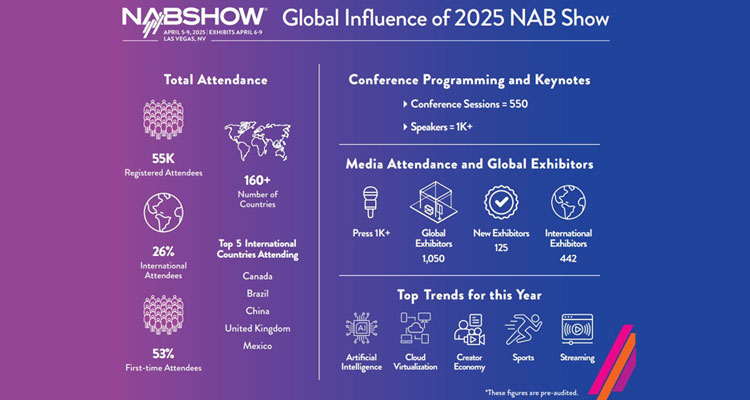Se espera una fuerte presencia de directivos de empresas de América Latina este año en Las Vegas, del 15 al 19 de abril, en función de las necesidades de reequipamiento y adaptación a las nuevas tecnologías que enfrenta la industria en los principales mercados de la región.
El aislamiento por la pandemia, en 2021 y 2022, ha provocado además una necesidad de reencuentro personal de los funcionarios con sus proveedores, tanto para adecuarse a los avances como para poder responder a las necesidades urgentes surgidas de la operación habitual de las emisoras de radio y televisión, los proveedores de videojuegos, los sistemas de cable y los proveedores de Internet, acuciados por el auge del Streaming y de demanda de mayor y mejor conectividad por parte de los usuarios jóvenes, que se caracterizan actualmente por su necesidad de mantener una interactividad constante con sus amigos pero también con fuentes de información y entretenimiento.
Si bien es cierto que países como Argentina atraviesan por una complicada situación económica, y la inflación ha aumentado en otros, el negocio de la radiodifusión es demasiado dinámico como para que puedan permitir que otros jugadores invadan su área de actividad.
El ingreso de múltiples plataformas de video como Netflix, Amazon Prime, Disney y Warner Media ha multiplicado esta situación, al mismo tiempo que los proveedores locales de conectividad están sintiendo –al igual que en otras partes del mundo— una demanda de contenidos sólo limitada por la capacidad de pago de los usuarios.
En estas condiciones, se están agregando múltiples servicios FAST (Free Advertised Streaming Services) que agregan competencia al mercado de Streaming y ponen más contenidos, incluyendo muchos antes existentes pero no disponibles, al alcance de los consumidores.
Otro aspecto a considerar es que, a diferencia de los Estados Unidos, donde la TV de paga lineal está sufriendo pérdidas apreciables de suscriptores, en la mayoría de los países de América Latina (excepto Brasil y Venezuela) se ha mantenido constante o con pérdidas leves. Esto se debe a que la mayoría de los operadores ofrecen canales locales de noticias y a que, en países como Argentina, es limitada la oferta de televisión de aire, por lo cual ‘el cable’ sigue cumpliendo funciones de información y entretenimiento para millones de usuarios.
Además, la adquisición de DirectTV en América Latina por parte del grupo argentino Werthein ha significado un cambio de orientación en sus operaciones que, de acuerdo a los analistas de mercado, representará una transformación que aumentará su importancia en las zonas de difícil acceso para las redes terrestres y un reposicionamiento de mercado a través –nuevamente—de la oferta de contenidos propios.
La telefonía es otro ejemplo: de acuerdo a la consultora mexicana The Ciu, las líneas fijas sumaron 24.2 millones al 4T22, cifra equivalente a un crecimiento anual de 6.5%. La TV restringida creció 6,8% en tanto los ‘servicios convergentes y móvil’ crecieron 6,4%. El crecimiento de las telecomunicaciones en general fue estimado en 5,2 para 2022 y para 2023 entre 3,3 a 4,9%, según la evolución de otros factores.
En Argentina hay gran expectativa por la anunciada licitación este año de frecuencias para telecomunicaciones 5G, por un total de 300 MHz entre 3300 y 3600 MHz, para la prestación de los servicios de telecomunicaciones. El país estará presente en NAB 2023 con una delegación oficial, coordinada a través de CAPER, la Cámara empresaria de fabricantes e importadores de tecnología de comunicaciones y conectividad.
Igualmente interesante es la estrategia de varios gobiernos –como Colombia y Perú— a favor de aumentar la conectividad a través del apoyo a la construcción de infraestructura y la liberalización –en Colombia—del otorgamiento de licencias para ISPs, con una red de 20.000 kilómetros que conecta 1075 municipios, de acuerdo al Ministerio de Tecnologías de la Información y Comunicaciones (MINTIC).
En Perú, la Red Dorsal de Fibra Óptica tiene 15.000 Kms y llega a 180 capitales de provincia, sumada a otros proyectos que, al completarse, llegarán a 29.000 kilómetros de longitud y cubriendo regiones aisladas, como la Selva Amazónica.
México es otro de los países donde se observa un aumento en la demanda de conectividad geográfica, con Telmex, la empresa líder, a través de Telcel, operando una red 330.000 Kms. Otros jugadores importantes son Totalplay, del Grupo Televisión Azteca (95.633km), Altan, que opera la red de la CFE, 70.240km), Televisa (54.000km), CFE Telecom (50.808km), Axtel (44.300km) y Megacable (21.245km). De acuerdo al BNAmericas, el mercado está liderado por Telcel con una participación de 43%, seguida de Televisa (26%), Megacable (15%) y Totalplay (14%).
En Argentina existe ya la Red Federal de Fibra Óptica con 34.000 Kms de extensión y más de mil localidades alcanzadas que, de ser aprovechada adecuadamente, se traducirá en una expansión igualmente fuerte de la demanda.
Uruguay tiene una red de este tipo denominada RedUy, y su gobierno ha logrado recientemente promulgar una ley que abre al sector privado el acceso directo a Internet, en lugar de estar obligado a hacerlo a través de la telco estatal Antel.
En Brasil hay registradas más de 15.000 empresas proveedoras de conectividad, y esto representa un enorme mercado potencial para los servicios adicionales que se puedan ofrecer más allá de los principales actores del mercado.
NAB 2023: strong Latin American participation expected
Hundreds of executives from Latin American companies will be attending this year the NAB convention in Las Vegas, from April 15 to 19, due to market expansion, the existing needs for replacing equipment and adaptation to new technologies faced by the industry in the main countries of the region.
The isolation resulting from the pandemic, in 2021 and 2022, has also caused an entrepreneur need to personally meet their suppliers, both to adapt to the technical developments available now, and the ability to respond to urgent needs arising from the regular operation of radio stations, television, video game providers, cable systems and Internet providers, in addition to the rise of Streaming platforms and the demand for greater and better connectivity by young users, characterized by their need to maintain constant interactivity with his friends but also with sources of information and entertainment.
While it is true that countries such as Argentina are going through a difficult economic situation and inflation has increased in others, the broadcasting business is too dynamic at them to allow other players to invade their marketplace. The entry of multiple video streaming platforms, among them Netflix, Amazon Prime, Disney and Warner Media, has reinforced this situation; at the same time, local connectivity providers are feeling – as in other parts of the world– a not unlimited demand for content, related to their users’ purchasing capacity; this forces lowering operation costs.
Under these circumstances, many FAST (Free Advertised Streaming Services) services are being added within the region. This adds competition to the Streaming market and makes more content available, including series and movies previously existing but unavailable to the reach of many consumers.
Another aspect to consider is that, unlike the United States, where linear Pay TV is suffering appreciable subscriber losses, in most Latin American countries (except Brazil and Venezuela)this business has remained stable or with slight losses.
This is due to the fact that most cable operators offer local news and commentary; in countries such as Argentina, the number of broadcast TV stations is limited, which is why «cable» and “satellite” (as they are usually named) continue supplying information and entertainment to 9.5 million subscribers. In addition, the acquisition of DirectTV in Latin America by Argentine group Werthein has resulted in a change of strategy for its operations. This, according to market analysts, will represent a changeover that will increase its importance in areas that are difficult for networks to access.
Telephony is another example: according to t Mexican consultant The Ciu, fixed lines totaled 24.2 million in 4Q22, implying 6.5% annual growth. Linear Pay TV grew 6.8% while «convergent and mobile services» expanded by 6.4%. The growth of telecommunications in general was estimated at 5.2% for 2022 and between 3.3 and 4.9% this year, depending on the evolution of other factors.
In Argentina, there is great expectation around the tender announced for this year for frequencies for 5G telecommunications, representing a total of 300 MHz at 3,300 through 3,600 MHz, for the provision of telecommunications services. The country will be attending NAB 2023 with an official delegation, coordinated through CAPER, the Business Chamber of manufacturers and importers of communications and connectivity equipment and technology.
Equally interesting is the strategy at several other countries –among them Colombia and Peru– to increase connectivity through support for the construction of infrastructure and the liberalization -–in Colombia– of the granting of licenses for ISPs, with a network of 20,000 kilometers that connects 1,075 municipalities available for use, according to the Ministry of Information and Communication Technologies (MINTIC)
In Peru, the Fiber Optic Dorsal Network has 15,000 km and reaches 180 provincial capitals, added to other projects that, when completed, will reach 29,000 km in length and cover isolated regions, such as the Amazon Forest.
Mexico is another of the countries with an increase in the demand for widespread connectivity, with Telmex, the market leader through Telcel, operating a 330,000 km network. Other important players are Totalplay, controlled by Grupo Televisión Azteca, (95,633 kms ); Altan, which operates the CFE network, 70,240km); Televisa (54,000 km), CFE Telecom (50,808 kms), Axtel, (44,300kms) and Megacable (21,245 kms). According to BNAmericas, the market is currently led by Telcel with a 43% share, followed by Televisa (26%), Megacable (15%) and Totalplay (14%).
In Argentina the Federal Fiber Optic Network has been built up to a 34,000 km overall extension with more than a thousand localities reached which. This, if adequately used, will result in an equally strong expansion of demand. Uruguay already has such a network, called RedUy, and its government has recently succeeded in enacting a law that opens direct Internet access to the private sector, instead of being forced to do so through state telco Antel. In Brazil, in addition to the pay TV players, there are more than 15,000 registered connectivity providing companies, which represents a huge potential market for additional services that can be offered beyond those already in the market.




